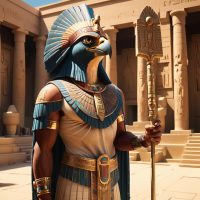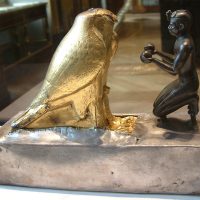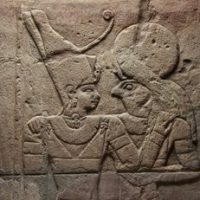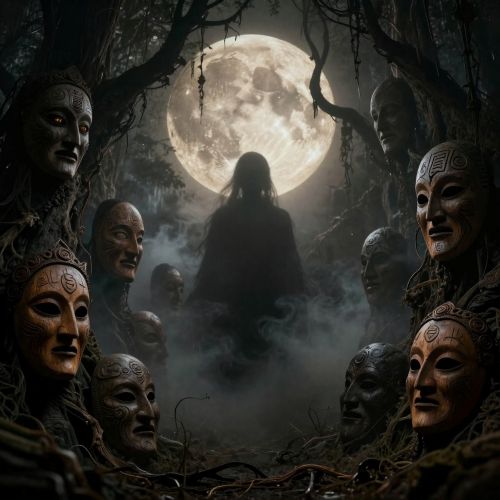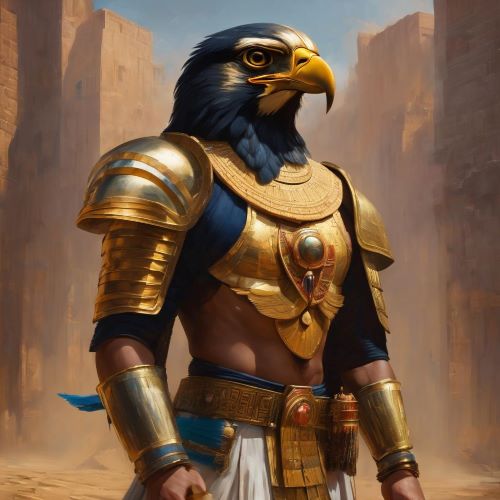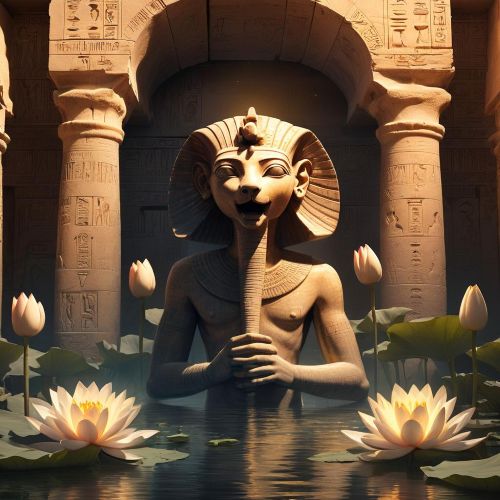Hemen : The Falcon God
Listen
At a glance
| Description | |
|---|---|
| Origin | Egyptian Mythology |
| Classification | Gods |
| Family Members | N/A |
| Region | Egypt |
| Associated With | Fertility, Protection |
Hemen
Introduction
Hemen is a fascinating and relatively lesser-known deity from ancient Egyptian mythology, worshipped primarily as a falcon god embodying strength, fertility, and divine kingship. His worship dates back to the Old and Middle Kingdoms, with a particular prominence in regions such as Hefat and Asphynis, located near Thebes in Upper Egypt. The name Hemen is believed to derive from an ancient Egyptian root meaning “the strong one,” a fitting description for a god associated with protection, vitality, and the life-giving powers of nature. Though overshadowed by more widely revered gods such as Horus and Ra, Hemen’s localized cults reveal the complexity and diversity of Egyptian religion, where regional deities played vital roles in everyday life and agricultural prosperity.
Hemen’s temples and shrines served as important centers of ritual activity, and evidence from inscriptions and statues—particularly the statue of King Taharqa offering to Hemen—illustrates the god’s enduring importance in linking divine protection to royal legitimacy. His worship connected both celestial and earthly realms, representing the eternal balance between the power of the sun, fertility of the land, and protection of the people.
Physical Traits
Hemen was most often depicted as a falcon or a man with a falcon’s head, mirroring the iconography associated with other sky and solar gods such as Horus and Ra. The falcon symbolized divine vision, strength, and guardianship, qualities central to Egyptian concepts of kingship and cosmic order. In temple art and sculpture, Hemen’s image frequently appears regal and commanding, often accompanied by solar disks or protective emblems.
One of the most significant artistic representations of Hemen is a statue depicting Pharaoh Taharqa kneeling before him. This statue, now preserved in the Louvre, portrays Hemen as a grand falcon figure crafted from stone and gilded with gold, while Taharqa is rendered in bronze with fine linear detailing. The contrasting textures and colors emphasize the dynamic between divine light and mortal devotion, capturing the essence of Egyptian spiritual ideology where the pharaoh acted as mediator between the gods and humankind.
In other artistic depictions, Hemen is shown carrying a scepter or wearing a feathered crown—symbols of balance, truth, and royal power. His avian form further connects him to the heavens, reinforcing his identity as a solar deity whose presence sustained both kings and commoners alike.
Family
Unlike major Egyptian deities with well-documented family lineages, Hemen’s genealogy remains obscure. Ancient Egyptian religion often allowed regional gods to evolve independently before merging with other prominent deities. Over time, Hemen became closely associated with Horus, leading to composite forms such as Horus-Hemen and Horakhte-Hemen (Horus of the Horizon-Hemen). These syncretic combinations linked Hemen to Horus’s divine family, symbolically associating him with Isis and Osiris as part of the broader cosmic cycle of life, death, and rebirth.
In certain regions, Hemen’s characteristics aligned with the fertility god Min, suggesting that both deities represented complementary aspects of male generative energy and agricultural abundance. Some interpretations even pair Hemen with Hathor, the goddess of love and fertility, highlighting his role in maintaining balance between masculine and feminine creative forces within Egyptian cosmology.
The lack of a fixed mythological family underscores the fluid nature of Egyptian theology, where gods were defined more by function and symbolism than by rigid narratives.
Other names
Hemen’s identity varied slightly depending on time and location, reflecting the flexible and adaptive character of Egyptian religion. In some inscriptions, he appears as Horus-Hemen, representing a fusion of his essence with the sky god Horus. In others, he is called Horakhte-Hemen, connecting him directly to the solar cult of Ra-Horakhty, the “Horus of the Two Horizons.” Another regional title, Lord of Tuphium, refers to his patronage over specific cities along the Nile.
Occasional linguistic variations and local spellings suggest that Hemen’s name may have been transliterated differently across dialects or historical periods. Regardless of the variation, all references emphasize his role as a powerful, protective deity embodying divine strength and solar vitality.
Powers and Abilities
Hemen’s divine powers encompassed protection, fertility, kingship, and cosmic balance. As a falcon god, he represented the vigilant watch of the divine over the world, ensuring the triumph of order (ma’at) over chaos (isfet). Ancient inscriptions and artistic depictions often show Hemen spearing hippopotami—symbols of chaos and destruction—illustrating his role as a warrior deity defending the balance of creation.
Hemen was also deeply connected to fertility and the agricultural cycles sustained by the Nile. Offerings and rituals dedicated to him during planting and harvest seasons invoked his blessings for abundant crops and prosperous floods. His solar associations further linked him to renewal and vitality; like the sun rising each day, Hemen symbolized continuous rejuvenation and the cyclical nature of life.
Pharaohs, particularly Taharqa of the 25th Dynasty, revered Hemen as a divine protector and source of royal legitimacy. Through offerings and temple dedications, rulers sought his favor to secure strength in battle and divine sanction for their reigns. Hemen’s fusion of solar and fertility attributes positioned him as both a celestial guardian and a provider of earthly abundance—a duality that resonated with Egypt’s vision of divine kingship.
Modern Day Influence
Although Hemen’s cult eventually faded with the decline of ancient Egyptian religion, his legacy endures through art, archaeology, and scholarship. The statue of Taharqa and Hemen remains a remarkable example of Kushite-Egyptian artistry and a vital link in understanding how regional deities contributed to the political and spiritual landscape of ancient Egypt.
In modern Egyptology, Hemen serves as a case study in how localized gods were integrated into broader religious systems, illustrating the fluid boundaries between cults and the adaptability of Egyptian theology. His role as a solar-fertility god has also sparked renewed interest among historians exploring the ecological and agricultural symbolism embedded in Egyptian religious practices.
Contemporary spiritual movements, such as Kemeticism—the modern revival of ancient Egyptian religion—sometimes include Hemen in fertility and abundance rituals, celebrating his attributes of strength, protection, and balance with nature. His falcon imagery continues to inspire modern art, museum exhibits, and educational materials focused on Egypt’s mythological heritage.
Hemen’s mythology, though less famous than that of Horus or Ra, represents a vital thread in the vast tapestry of Egyptian spirituality. Through his enduring symbolism of solar vitality, royal authority, and natural renewal, Hemen remains a timeless embodiment of the harmony between divine power and the cycles of life that sustained one of history’s greatest civilizations.
Related Images
Source
World Mythos. (2024, December 18). Hemen. Retrieved from https://worldmythos.com/hemen
Egyptian Tours Portal. (2025, May 19). 60 famous ancient Egyptian symbols (meanings & facts). Retrieved from https://www.egypttoursportal.com
Wikipedia. (2025). Hemen. Retrieved from https://en.wikipedia.org/wiki/Hemen
Think Reload. (2025, September 8). Statue of Taharqa making an offering to the falcon Hemen at the Louvre. Retrieved from https://thinkreload.com/statue-taharqa-offering-hemen-louvre
Wikipedia. (2011). List of Egyptian deities. Retrieved from https://en.wikipedia.org/wiki/List_of_Egyptian_deities
Wikipedia. (2007). Ancient Egyptian deities. Retrieved from https://en.wikipedia.org/wiki/Ancient_Egyptian_deities
British Museum. (n.d.). Ancient Egyptian gods and goddesses. Retrieved from https://www.britishmuseum.org
Encyclopedia.com. (2025, September 1). Egyptian myths. Retrieved from https://www.encyclopedia.com/humanities/culture-magazines/egyptian-myths
Frequently Asked Questions
What is lorem Ipsum?
I am text block. Click edit button to change this text. Lorem ipsum dolor sit amet, consectetur adipiscing elit. Ut elit tellus, luctus nec ullamcorper mattis, pulvinar dapibus leo.
What is lorem Ipsum?
I am text block. Click edit button to change this text. Lorem ipsum dolor sit amet, consectetur adipiscing elit. Ut elit tellus, luctus nec ullamcorper mattis, pulvinar dapibus leo.
What is lorem Ipsum?
I am text block. Click edit button to change this text. Lorem ipsum dolor sit amet, consectetur adipiscing elit. Ut elit tellus, luctus nec ullamcorper mattis, pulvinar dapibus leo.
What is lorem Ipsum?
I am text block. Click edit button to change this text. Lorem ipsum dolor sit amet, consectetur adipiscing elit. Ut elit tellus, luctus nec ullamcorper mattis, pulvinar dapibus leo.
What is lorem Ipsum?
I am text block. Click edit button to change this text. Lorem ipsum dolor sit amet, consectetur adipiscing elit. Ut elit tellus, luctus nec ullamcorper mattis, pulvinar dapibus leo.


